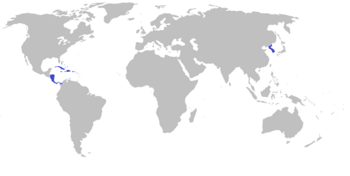Third Han
Jump to navigation
Jump to search
Third Han 丙韓 Byeong Han (Korean) | |||||||||
|---|---|---|---|---|---|---|---|---|---|
| 1812–1905 | |||||||||
 The Third Han at its height in 1890 | |||||||||
| Capital | Hanseong | ||||||||
| Government | Monarchic military dictatorship | ||||||||
| Monarch | |||||||||
• 1812-1830 | King Sol | ||||||||
• 1830-1839 | Queen Samtae | ||||||||
• 1839-1856 | King Noksan | ||||||||
• 1856-1889 | King Namgung | ||||||||
• 1889-1905 | Queen Saebyung | ||||||||
| State Councellor | |||||||||
• 1812-1823 | Cho Guk (first) | ||||||||
• 1900-1905 | Park Sen (last) | ||||||||
| Legislature | National Diet | ||||||||
| History | |||||||||
| 15th December 1812 | |||||||||
| 4th May 1905 | |||||||||
| Population | |||||||||
• 1890 Estimate | 29,000,000 | ||||||||
| Currency | Won | ||||||||
| |||||||||
The Third Han (Korean: 丙韓; Byeong Han) was a nation that existed from the dissolvement of the Daikon in 1812, to 1905, when the Han peninsula was annexed by Empire of Ilban.
The Third Han came into existence after the December Coup, when military leader Cho Guk marched the Royal Army into the Royal Palace and ousted Ilban loyalists, proclaiming a new sovereign nation and restoring Han Clan rule. Due to an unstable political state at home, the coup was met with little resistance by Japan, and all Japanese troops withdrew from all territories claimed by the new Han.
